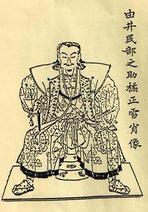 Source: the-mystery.net
Source: the-mystery.net This rebellion took place in the 4th year of Keian (1651), and was an attempt by groups of rōnin to revolt against the Tokugawa Bakufu. It is also known as the Keian Incident (慶安事件). The leader of the revolt was a military strategist by the name of Yui Shōsetsu and rōnin by the name of Marubashi Chūya, Kanai Hanbe`ei, and Kumagaya Saburō Hei`ei.
In the aftermath of the Battle of Sekigahara (1600), the Tokugawa Bakufu set about re-arranging the local of regional daimyō families or else seized their territory and drove them into ruin. This process continued so that by the time of the third Shōgun Iemitsu there were an estimated 40,000 rōnin (masterless samurai) throughout the realm. Not content with this, the Bakufu also went about expelling rōnin from the capital at Edo and increased penalties and measures to clamp down on rōnin in general. During the Kanei period (1624-44), new measures were imposed on daimyō to prevent them from expanding their number of household retainers, and so the unease of the rōnin grew even further.
It was around this time that Yui Shōsetsu opened up a school of military strategy in the Kusunoki style at Kanda Renjyaku (modern Chiyoda ward, Kanda Suda-machi), where many of his students were members of daimyō households as well as rōnin. At the same time, Marubashi Chūya was a renowned practitioner of the Hōzōin style of crossed spears, and opened a dōjō at Ochanomizu (Chiyoda ward). Both Shōsetsu and Chūya were dissatisfied at the way of the world and seeking a means to help rōnin. They eventually decided to join together and work to `correct` what they regarded as a corrupted Bakufu. Such was their influence that soon many rōnin were flocking to join either of their schools.
In the 4th year of Keian (1651), Iemitsu died of illness. His successor, Ietsuna, was but an infant when he was named as the next Shōgun. Sensing an opportunity, Shōsetsu then hatched a plan whereby uprisings against the Bakufu would occur simultaneously in Edo, Sunpu (located in what is now central Shizuoka prefecture), Kyoto, and Osaka.
The plot is discovered after secret missives sent
According to the plan, Shōsetsu would make his way to Sunpu, seize the treasure of Ieyasu on Kunōzan (in modern Shizuoka city), and from there direct the rebellion. In Edo, Marubashi Chūya would direct the rōnin, destroy the fire extinguishing warehouses in Koishikawa (modern Bunkyō ward), set fire to buildings at a number of points throughout the city, and then use the ensuing chaos to attack Edo castle and seize the Shōgun. At the same time, Kanai Hanbe`ei in Osaka and Kumagaya Saburō Hei`ei in Kyoto would lead rōnin in those cities against local representatives of the Bakufu.
However, some of the plotters got cold feet and informed the Bakufu of the plan. On the 22nd of the 7th month of the same year, Marubashi Chūya was arrested, and was later executed by crucifixion on the banks of the Shinagawa. Shōsetsu, and 10 of his accomplices, were lodging at Umeya in Sunpu when their lodgings were surrounded by men belonging to the local Sunpu magistrate. On the 26th of the same month, Shōsetsu and his accomplices all committed ritual suicide. The Bakufu then launched a nationwide search for other accomplices, rounding up another 30 or so rōnin. Shōsetsu left a will before he died, in which he explained that his intention had not been to overthrow the Bakufu but to instead rescue rōnin from a life of destitution and reform the system of politics.
This incident awoke the Bakufu to the difficulties being faced by rōnin, and so the policy of reform of the daimyō system was eased, thus making this an important turning point in the political policies of the nation. (pp.199-200)
 RSS Feed
RSS Feed